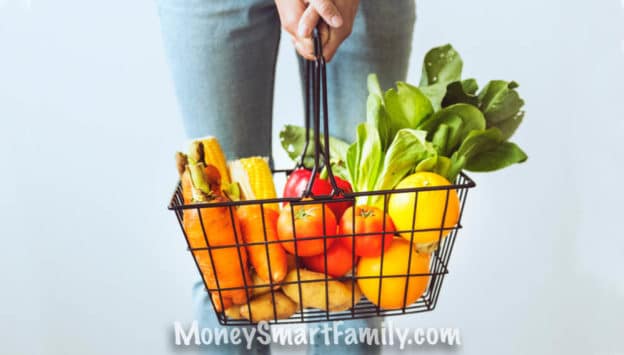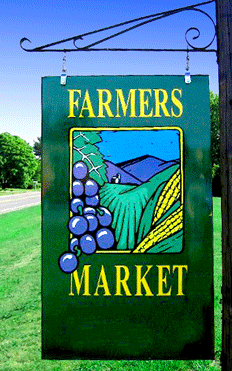Are you looking for ways to eat healthier organic food on a budget? Have you ever asked, “How can I save money on organic food?”
We are always asked about how to save money on organics every time we do a grocery seminar or take phone calls during a radio interview on grocery savings.
Why Does Organic Food Usually Cost More?
Organic food products, on average, cost 50 percent more than standard foods. But you could end up spending 100 percent more, especially on dairy products and meat.
According to Fox News there are several reasons Organic foods cost more:
- More Labor intensive to grow
- Natural fertilizers instead of chemicals
- Demand overwhelms supply
- Crop rotation to keep soil naturally healthy
- Separate handling from non-organic food
- Organic certification costs between $400 and $2000 annually
- Organics grow more slowly
Organic Food Sales are Growing
According to Nielsen, U.S. retail organic food sales totaled $10.4 billion in 2004.
Oklahoma State University Extension service reported U.S. organic food sales totaling nearly $17 billion.
In 2021 SupermarketNews reported that Organic Food Sales in the U.S Topped $56.5 billion (13% higher than in 2019).
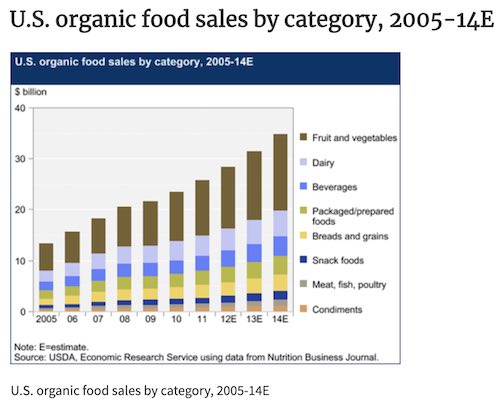
Usually when sales in a specific product sector increase there will be an offsetting reduction in price. This is what we’ve seen as more retailers bring organic foods into their product line-ups.
Why Do Consumers Choose Organics
There are 3 main reasons consumers choose organic food:
- Overcoming severe health issues
- Seeking a healthier lifestyle: Avoidance of pesticides and additives.
- It’s in vogue to eat organic
How Can I Save Money on Organics?
Is there any way to get healthy, hormone-free and pesticide-free organic food for less money?
Many people we’ve talked to are resigned to endure a heavily increased food budget to accommodate their desire for organics.
What should you do if you want to eat organic food, but have a smaller budget?
TABLE OF CONTENTS
- 1 12 secrets to save some money on organic foods.
- 2 1. Learn Which Stores Sell Organics
- 3 2. Look for Organic Salvage
- 4 3. Outlets, Markdowns & Retail Sales
- 5 4. Buy Enough, But Not Too Much
- 6 5. Best Foods to Buy Organic
- 7 6. Save on Organic Milk
- 8 7. Save on Organic Meat
- 9 Buy Meat Online
- 10 8. Grow Your Own Organics
- 11 9. Find Organic Food Coupons
- 12 10. Join an Organic Food Coop
- 13 11. Go to a Farmer’s Market
- 14 12. Learn More: Is Organic Food Worth the Cost – Prager U
- 15 Summary
- 16 Bonus: Organic Tips from Readers
12 secrets to save some money on organic foods.
We’ve compiled an extensive list of ways to eat Organic Food on a budget. We hope you save a boodle.
1. Learn Which Stores Sell Organics
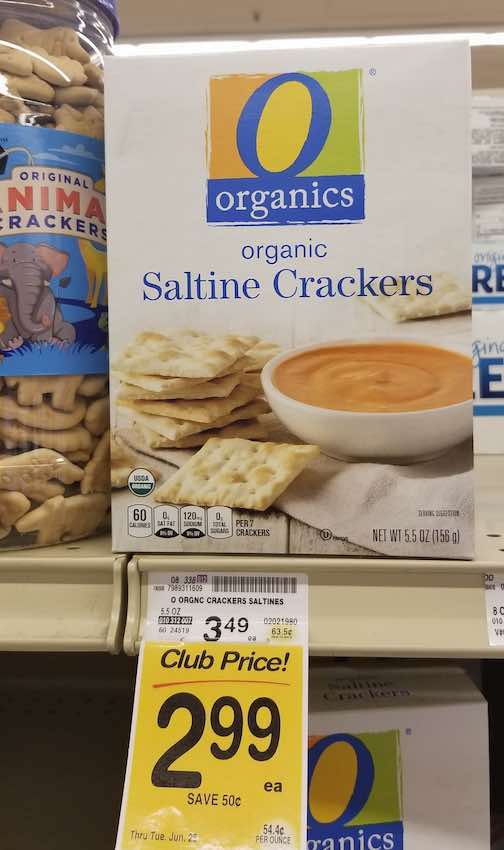
As organics grow in popularity we’re seeing more or them advertised on a weekly basis in-store circulars. We’ve even seen organic chicken breasts for less than $2 per pound at Sprouts (they are in 20 states across the country). That’s the time to stock up and freeze them.
If we do end up buying a lot of one particular cut of meat, we usually divide it up into plastic zippered bags or repackage it into meal-sized servings.
Be sure to join your local stores’ loyalty programs so you can be notified of these sales. And when you hear of one stock-up!
Other Stores that are known to sell organic foods:
- Aldi’s (1885 stores in 9 states)
- Costco (762 locations worldwide)
- Kroger (2764 stores in the U.S. – several different brands)
- Natural Grocers (154 stores in 19 states) is are a more expensive option
- Safeway (900 stores in the U.S. – several different brands)
- Target (251 SuperTarget stores in the U.S.)
- TraderJoes (474 U.S. stores in 43 states and in Washington, D.C.)
- Whole Foods (499 stores in North America & the United Kingdom)
Imperfect Foods – Get $80 off:
Imperfect Foods is a newer online store that carries many organic products. Our daughter, Abbey, turned us on to their deals.
Here’s what she wrote, “Hey, check out Imperfect! They have an amazing selection of affordable, sustainable groceries, and deliver to your door.”
“Here’s $80 to shop ($20 off your first four orders) and create your Imperfect box. You can thank me later :)”
Here’s what Imperfect Foods says about its organic offerings:
We offer both organic and conventional groceries. You get to pick exactly what you want in every order! All of our organic products are non-GMO. If you’d like a box with all organic fruits and veggies, you can specify that during sign up, or by choosing only organic produce when customizing your box
ImperfectFoods.com
Most grocers now have a small section in their weekly ads devoted to organic foods. And you’ll also find organics searchable in the store apps.
Use Flipp to Monitor Organic Sales

We like the Flipp app to search multiple stores for their sale items.
Plan Sale Items into your Menu
Picking up discounted deals on organics is a great way to save. But planning your weekly menu around those items on sale is even better. And if you buy more of the sale items than you can consume this week, and can store it, your savings will be even greater.
We recommend each family invest in a chest freezer. Being able to freeze your meat deals and some properly prepared produce and bread will extend the savings you get.
RELATED ARTICLE: Foods that Freeze Well
2. Look for Organic Salvage
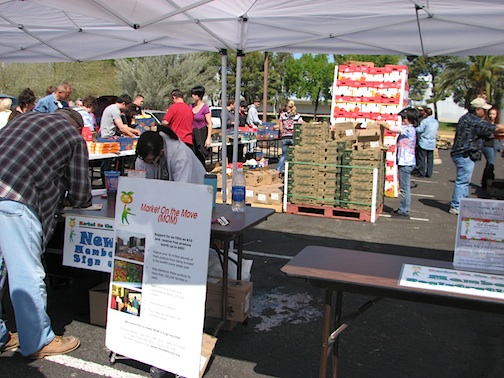
We’ve seen shelf items of organic food at the grocery store on the discount shelf. But there are also dented can stores that will have some shelf-stable organics too.
In Arizona, we have two produce rescues
They charge $10 for up to 60 lbs of produce. We’ve picked up some organic produce items several times from both of these rescue groups.
Research Produce Rescue near me to see if your city has something similar.
3. Outlets, Markdowns & Retail Sales
We’ve found organic products at Big Lots and some Dollar Stores. Keep your eyes peeled you may be surprised. Like this loaf of Oroweat Organic bread for $2 from BigLots. What a great way to eat amazing organic food on a budget.
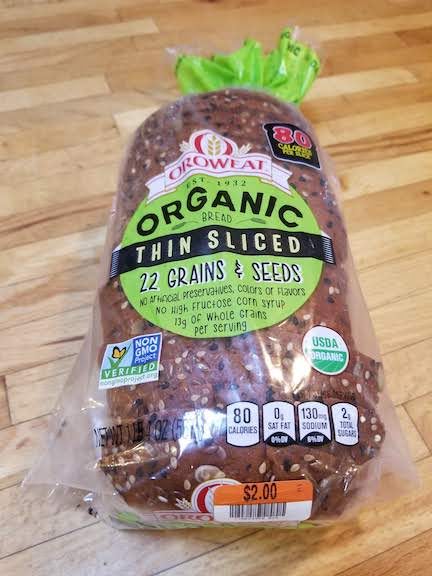
We’ve also seen Cage Free eggs steeply discounted at Kroger.
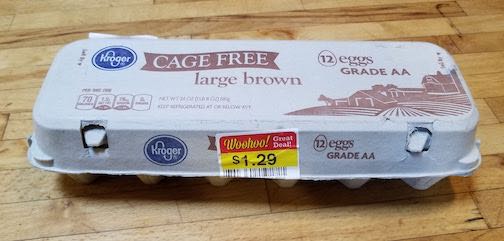
Safeway carries the O Organics brand and there have been times when we’ve seen these items on sale or closeout priced.
RELATED ARTICLE: How Long Can Eggs Last Unrefrigerated
4. Buy Enough, But Not Too Much
If you really want to save money on organic foods, we’ve got to be diligent to not waste any.
Store it Properly
Learning how to store organic produce so they don’t go to go bad is a must.
- Wash all produce in a water and vinegar solution to kill bacteria
- Trim stems that may be harboring bacteria
- Store carefully in your refrigerator to avoid bruising
Only buy enough highly perishable foods to last so they can be consumed before going bad.
Learn what foods can be frozen.
Things like organic berries (strawberries, blueberries, blackberries, and raspberries) and cherries all freeze really well.
Freeze It
We have also blanched and frozen organic green beans when we received more than 10 lbs of them through the produce rescue we participate in.
RELATED ARTICLE: Foods That Freeze Well
5. Best Foods to Buy Organic
Frugal organic foodies agree that eating “all organic” isn’t necessary. Many people wonder “Which Foods Are Best To Buy Organic?”
So if you’re looking to buy organic foods on a budget, you may need to think differently.
Conventionally farmed non-organic foods like avocados, bananas, onions, and pineapples are okay to consume. It’s recommended to save your organic food budget for things like meat, dairy and other produce items.
According to a Mayo Clinic bulletin and Consumer Reports (watch 2-minute video) research, some organic items really don’t provide any added health benefits or protection.
Both Mayo Clinic and Consumer Reports said that thick-skinned produce rarely allows even minuscule amounts of pesticides to penetrate through the skin. Consequently, they pose little-to-no health risk.
These thick-skinned produce items include:
- Avocados
- Bananas,
- Kiwis
- Mangos
- Onions
- Papayas
- Pineapples
Additionally, they said that hardy plants are very pest-resistant, and, therefore, farmers use little-to-no pesticides in growing them.
- Asparagus
- Broccoli
They encouraged saving your organic dollars for more perishable items to avoid the toxins and hormones regularly found in the non-organic versions.
These heavy pesticide-treated produce items include:
- Spinach
- Apples
- Peaches
- Nectarines
- Plums
- Milk
- Meat
Do your rice, pasta, grains, salsa, jelly, cereal, condiments and crackers all have to be organic too?
Focus on the areas of greatest exposure and health risk for you and your family, then determine your spending priorities and level. Allowing your grocery budget to provide spending boundaries is perfectly okay.
6. Save on Organic Milk
With organic milk selling for $6 to $10 per gallon you’ve got to be careful how you use and store it.
Try these tips to save money on organic milk:
Stretch your MIlk
Whole organic milk can be mixed with filtered water. But in reality, while it does make the milk go further, it also dilutes the nutrients in the milk.
You could buy non-fat organic powdered milk and mix it with the whole milk to make it go further. But powdered milk tends to be more expensive than fresh milk.
Drink Less Milk – Get More Calcium
This is especially important if you have kids. The recommended daily allowance of calcium for kids 9 to 18 years old is 1300 mg. Five (8-ounce) glasses of milk or three (8-ounce) servings of yogurt will meet that requirement. You could also supplement the family diet with these calcium-rich foods.
Recommended Daily Allowance of Calcium for Kids
- Toddlers – 3 years old: 700 mg
- 4 to 8 years old: 1000 mg
- 9 to 18 years old: 1300 mg
- Adults: 1000 – 1200 mg
Source: Medscape.com
Amount of Calcium in Dairy Products:
- 8 ounces of whole milk: 276 mg
- 8 oz Yogurt, plain, low fat: 415 mg
- 1.5 oz Mozzarella Cheese: 333 mg
Source: Osteoporosis.Foundation
Calcium-Rich Foods:
- Collard Greens 8 oz, Frozen: 360 mg
- Broccoli 8 oz: 200 mg
- Kale, Frozen 8 oz: 180 mg
- Soy Beans 8 oz Boiled: 175 mg
Source: National Osteoporosis Foundation
You could also take a calcium supplement if you want the nutrients, but want to drink less milk.
An old neighbor of Steve’s once said, “Drink water when you’re thirsty, drink milk when you’re hungry.” This axiom could also save you money on organic milk.
7. Save on Organic Meat
We’re always looking for deals on meat. We don’t mind buying meat that is close to expiration dates because we know that aged meat is more tender. There are several ways to spend less on organic meat … are you willing to try some of these?
Stretch Your Meat
We received a note from an Asian/American visitor telling us that where he grew up meat was very expensive. So his parents would cut the meat into smaller pieces and use it to add flavor to beans, rice or quinoa. In other words, meat was not the main dish. And they used other less expensive protein sources to feed their bodies.
Stock Up on Sales
As the popularity of organics increases, more mainstream grocers are advertising organic meat for sale. We’ve seen organic boneless, skinless chicken breast for as little as $.99 per pound in Arizona. That’s as cheap as the non-organic ones!
Because organics are so common now, you may find a retailer overstocked. In this case, you’ll usually see a manager’s special markdown to sell off the excess inventory.
This is when a chest freezer comes in handy. When we find a closeout, super-reduced sale on meat, we buy as much as we can store. Then we deplete that discounted meat over the next few months!
Buy Meat Online
There are a few online sellers of organic meat. We’ve only tried one, but have talked to friends who have tried some of the other ones. Organic, free-range and grass-fed meats are pricey. But they also are better for your body – especially if you have dietary sensitivities or health issues you are trying to overcome.
Try these sources for buying meat in bulk online:
Butcher Box
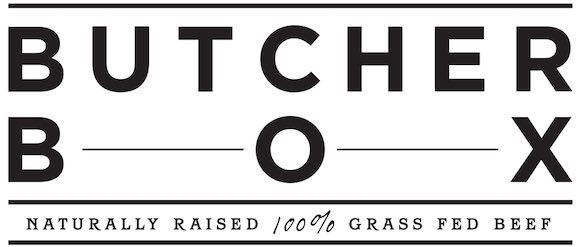
Butcher Box is a company that sells 100% grass-fed, free-range and organic meat, completely online. Essentially, they’re like the neighborhood butcher that sells premium meat except ButcherBox does it only via a monthly subscription. They have two basic box sizes that you can fill for a flat rate price.
Their subscription is basically that you agree to receive a shipment of meat (a Classic Box or Big Box) every month or every other month.
How ButcherBox works:
Set-Up: If you want to browse their inventory, you’ll need to set up an account (no credit card is necessary. On the home page, you’ll be asked to enter your email address and zip code. You can browse selections and play with various combinations of meats in your box.
Select a Box Size: Box Sizes include:
– Classic Box: 9 to 14 lbs of up to 6 selections of meat: $149
– Big Box: 18 to 26 lbs of up to 12 selections of meat: $270
Select Your Cuts of Meat: Click to select the various cuts of meat you want to fill your 6 or 12 selections.
They also give you the option to select to add more cuts of meat as “add-ons.” Of course, these add-ons do cost more.
Delivery Information: Lastly, you add your personal delivery information and pay for your order. They do not charge for delivery.
That’s all there is to it.
ButcherBox has a 100% money-back satisfaction guarantee. And they say that you can cancel your subscription at any time by emailing them.
How your order is packed and delivered:
Your order is delivered to your address in an insulated cooler with a specific amount of dry ice that is calculated based on your location. Orders are delivered within 5 to 8 days of being placed. They only deliver to residences or office locations – no PO Boxes.
Scheduled Orders: Recurring subscriptions can be set for every month or every other month.
Bonus Offers from Butcher Box:
Get Started with Butcher Box. They are always offering first-time subscribers a free bonus. We’ve seen 2 lbs of Wild Alaskan Salmon and 2 lbs of Sirloin Tips offered as a free bonus at various times.
Compare Costs for Butcher Box (2019)
Organic Boneless Skinless Chicken Breasts
– Classic Box: 18 lb Organic Chicken Breasts $149: $8.28 per pound
– Big Box: 36 lb Organic Chicken Breasts $270: $7.50 per pound
Grass-Fed Beef – NY Strip Steaks
– Classic Box: 12 X 10 OZ NY Strip Steaks 7.5 ib for $149 = $19.86 per pound
– Big Box: 24 X 10 OZ NY Strip Steaks 15 ib for $270 = $18 per pound
Thrive Market Organics

Thrive Market sells more than 4,000 products that are Non-GMO and/or organic. They charge an annual membership fee of $59.95. But they promise that if you don’t save at least $60 in your first year they’ll refund the difference.
Shipping: Orders over $49 ship for free.
They claim that their products (food, beauty, and cleaning supplies) are discounted from 25 to 50 percent below retail prices.
New Customer Bonus
Thrive Market offers first-time buyers a 25 percent discount! You’ll also be given a FREE 30-day trial before they charge you the annual fee. That’s a huge saving.
Organic Meat Details
They do sell organic meats. Their offerings include:
- Sustainable Seafood
- 100% Grass-Fed Beef
- Organic Chicken
- Pasture-Raised Pork
- Value Variety Packs
Compare Costs for Thrive Market (2019)
Organic Free-Range Chicken Breasts
Deal: 14.25 lbs for Sale Price: $109.99 / $7.71 per pound
1st-time buyer with 25% off retail ($171.72) Final Price $128.79 = $9.037 per pound (The sale price above of $7.71 is a better deal)
NY Strip Steak Grass-Fed Beef
Deal: 7.88 lbs for $119.99 = $15.22 per pound
1st-time buyer with 25% off retail ($119.99) Sale Price $89.99 = $11.42 per pound (this 1st-time buyer price is a better deal)
8. Grow Your Own Organics
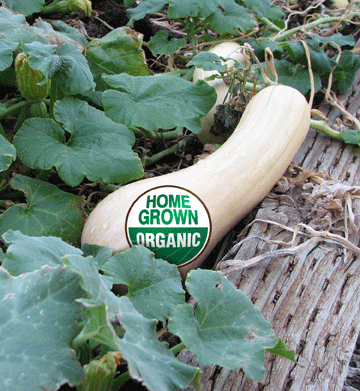
If you have space (and you don’t need a lot) to grow your own organic fruits and veggies, this is the best way to save money.
There are space-saving options that make apartment and condo gardening viable. When our daughter Becky and husband Nolan lived in an apartment they turned their balcony area into an organic garden complete with a worm farm!
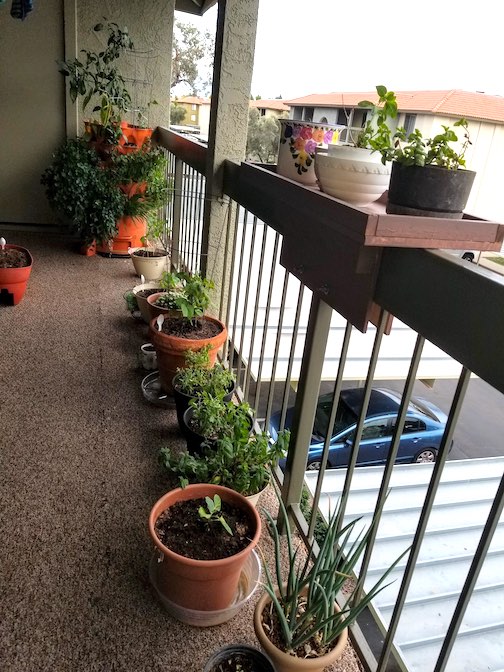
Becky has a stacking garden tower that saves a ton of space. These stacking gardens range in price from $36 to $60. She has peppers, tomatoes, and parsley growing in abundance.
If you live in a colder climate and want to garden year-round, consider the Earth Box. It’s a rolling garden bed with a built-in irrigation system. Some friends of ours grew amazing tomatoes and green peppers in Arizona. During the hottest part of the year, they could move it out of the direct sun to protect the plants. Earth Boxes cost between $30 and $70 on Amazon.
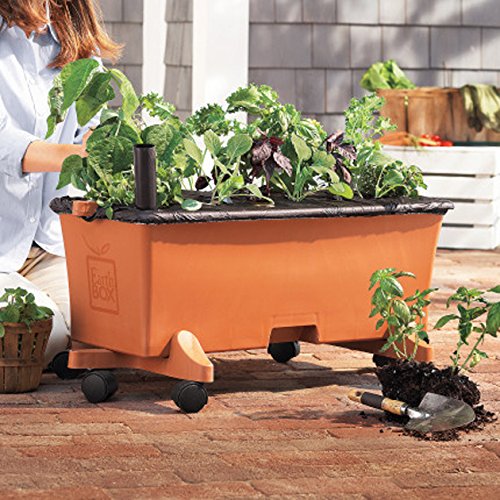
We recommend Mel Bartholomew’s book Square Foot Gardening for those who want to make a productive garden in a small space.
Grow Fruit Trees
We have a mini citrus orchard on our property. We’ve also grown fig trees and pomegranate trees from cuttings. For us, growing our own organic fruit trees is very rewarding.
Make Compost

We compost most of our yard waste and all of our vegetable and fruit scraps. We have a 3-bin compost system. One bin is fresh compost material, the second bin is “cooking, and the third bin is “done” compost. Composting in Arizona is a bit tricky, we actually have to water our compost in order for it to break down.
9. Find Organic Food Coupons
If you have a favorite organic food company, reach out to them via email or snail mail and request coupons for their products.
We’ve researched several coupon networks and found these organic coupons:
- Annie’s Organic Foods Coupons
- Simple Truth Product Coupons
- Stonyfield Yogurt – Join their email list and they’ll occasionally send you coupons
- Join Common Kindness. This e-coupon site has many partners that are natural or organic food companies – we’ve seen a number of organic product coupons here
- Coupons.com we occasionally see organic coupons on this site.
10. Join an Organic Food Coop
Joining with other organic-minded friends and buying directly from producers can net some huge savings. Or search for “organic food coop near me” and see what already exists in your area.
There is one large co-op that we know is in multiple states. Visit BountifulBaskets.org. It is a co-op that is run by volunteers. They have scheduled distributions and charge a fair price. Conventional Baskets are between $18 and $21, and 100% Certified Organic baskets are between $28 and $30.
We recently learned from our daughter Abbey, about a produce warehouse that allows consumers to order fruits and veggies by the case lot. They have many organic items for sale. Orders are placed online and then picked up at the warehouse. We’re in the process of putting together our own co-op to divide up the savings.
If you live in Arizona, learn more about Garcia Family Fruit to Happiness on Facebook.
Organic Farming Co-Ops
Join a farming co-op or share the work. Go to www.sare.org/coreinfo/consumers.htm (Sustainable Agriculture Research and Education) for a list of community-supported farms.
Volunteer at an Organic Farm
If you are interested in Travel and are willing to stay someplace for a weekend or more, consider staying on an organic farm.
The organization called World Wide Opportunities on Organic Farms (WWOOF) is a network of organic farms all around the world.
The host farms will provide you with a room and food, in exchange for help with their farm. This could be a really cool learning experience. They do have some farms that will take an entire family. Check the website out here with their most frequently asked questions.
Our daughter Becky volunteered at an organic farm for several years and we enjoyed fresh goat milk and loads of produce.
11. Go to a Farmer’s Market
If you have a Farmer’s Market in your area, going later in the day when vendors are packing up can net you some real savings.
Some of our friends have been able to purchase produce at 50 to 75 percent off.
You might even score some free organic food if you volunteer with one of the farmers or work with the organizers of the market.
12. Learn More: Is Organic Food Worth the Cost – Prager U
This is a great video, full of documented research, about the nutritional value, safety, and environmental impact of organic foods. Do you agree with their views?
Summary
Initially, you’ll need to work hard to cultivate inexpensive resources for organic food. But after a while, you’ll be able to cash in on your hard work.
Organics are becoming so mainstream that you should see more opportunities to buy discounted food.
So shop smart and keep your eyes peeled for discount deals. Be mindful of your grocery budget and buy the organic food you can afford. Enjoy eating healthier and maybe even start growing some of your own delicious organic food.
RELATED ARTICLE: Stores That Will Price Match Amazon Today!
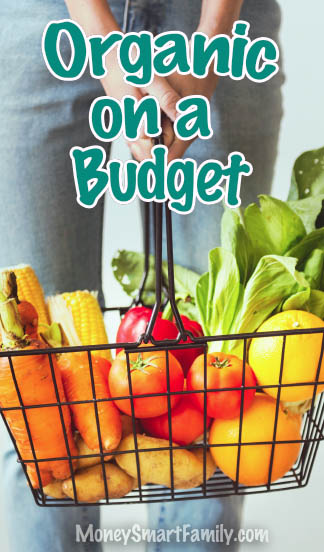
Bonus: Organic Tips from Readers
From the emails we receive, we know that organic foods are a hot topic. We are thrilled to have received these helpful tips from our readers. We hope their input encourages you to eat healthier and to save money.
Save on Organics in New York
Mendy Thorsland from Rock Stream, New York, shares how she saves money on organic food for her family.
I read your article on organic foods and had to write in. I am very concerned about what my children eat but want to have money for other things in life as well and so I had to write to tell you what we do.
1) Gardening
We have a huge garden and a large freezer. I freeze and can a lot of food. I also have many friends who do the same and we all trade things. For example, we have some grapevines that produce more than we can use and in the fall some friends come over and we spend a day making grape juice and jelly which we use all winter.
It is free, organic, tastes better than anything you will find at the store, and is a ton of fun because we do it together. Another friend has 10 organic apple trees and shares them with all of us.
2) Local Farms
We use Community Supported Agriculture. In the spring I paid a local farmer $350 for fresh produce all summer and fall.
Every Friday I go to the farm market, hand them my bag and they fill 1 to 2 bags full of fresh, organic, locally grown, heirloom vegetables. I have figured it out to $13 each week. It is a great deal for us as we live on fruits and veggies when they are in season.
3) Bulk Meat
We buy all of our meat in bulk. It comes from a local farmer and we pay about $2 to $3 per pound. Once a year we buy a whole pig or half a cow. It is pricey for ground beef but cheap for steaks and we feel it works out. It also supports a local farmer instead of the middleman.
4) Organic Salvage
Almost everything else we buy from a salvage store that gets in a lot of organic foods.
5) Homemade Stuff
I also make a lot of things . . . my own peanut butter, hummus, granola, granola bars, jellies, and cleansers, etc.
I know that we live in the country but I believe that living in more urban areas allows for other advantages that we do not have. For example, here everything is at least half an hour away. If you start asking around you may be surprised at what you will find.
Save on Organics in Scottsdale
Benita M. Dotson from Scottsdale, Arizona shared these ideas:
My husband and I were dumbfounded as to how much veggies and fruit have increased in stores. So I went on a hunt to purchase fresh veggies and fruits from local area farmers or a co-op. I discovered a co-op that for $17 (first visit) and $15 (after 1st visit) provided me with a bushel basket of various veggies and another bushel basket of various fruits every two weeks.
Plus if I volunteer, I get a few more little extras for free. I priced what I received from my first visit and realized that I had saved over $50! I’ve never been disappointed with the fruits or veggies and it seems that they last longer than what I’ve purchased in a store.
The co-op I belong to also has organics, herbs, bread, and honey, just to name a few. Just do a Google search for local farmers or food co-ops. It’s amazing what you will find. The co-op we belong to is BountifulBaskets.org.
Question from A Green Conscious Family
Question: What about “green”-conscious families, like mine, who are on organic/non-processed diets with recycled paper/plastic products, and non-toxic cleaners
They don’t have coupons for this stuff or carry it at warehouses. Do you have ideas to save money yet live healthy and environmentally friendly?
Editors’ Answer: We’ve seen several organic products and some environmentally friendly cleaning products at our local Costco. When buying “green,” do the principles of establishing a buy price and stocking up still apply.
Some Ideas for Saving Money on “Green” Products
Know your prices for the items you purchase. Over time and with research, you’ll find sources for what you want. Then when you find a better price, stock up.
Minimize the use of paper products. Disposable products are wasteful and costly. We use cloth napkins, cloth dishtowels, and old shirts for rags. We use very few disposable products.
Consider making some of your own cleaning products. Visit Pinterest; they have recipes for everything from air fresheners to homemade soap.
The best way to guarantee organic produce is by growing your own vegetables or planting fruit trees in your yard. Look for organic produce at farmers’ markets or join a co-op. Greg Peterson, a local “green” expert, is the owner of the Urban Farm in Phoenix. Learn about his ideas here: UrbanFarm.org
Going green is more expensive. So decide what the non-negotiable’s of your lifestyle are, find the best prices and work on saving money in other areas.
For more information about organic food, consider buying an autographed copy of our second book called, Cut Your Grocery Bill in Half.
For more ideas on medical care, see the medical chapter in our first book called, America’s Cheapest Family Gets You Right on the Money.

